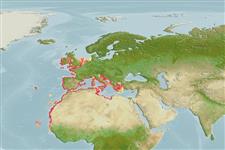Common names from other countries
>
Carangiformes (Jacks) >
Carangidae (Jacks and pompanos) > Naucratinae
Etymology: Campogramma: Greek, kampe, -es = curvature, bent + Greek, gramma = mark, signal, letter (Ref. 45335).
More on author: Lacepède.
Environment: milieu / climate zone / depth range / distribution range
Écologie
marin benthopélagique; profondeur 15 - 30 m (Ref. 7097). Subtropical; 56°N - 12°N, 26°W - 27°E
Eastern Atlantic: British Isles to Senegal including Madeira and the Canary Islands. Also western Mediterranean Sea.
Taille / Poids / Âge
Maturity: Lm ? range ? - ? cm
Max length : 60.0 cm FL mâle / non sexé; (Ref. 3397); common length : 58.0 cm TL mâle / non sexé; (Ref. 3397); poids max. publié: 2.8 kg (Ref. 27584)
Description synthétique
Clés d'identification | Morphologie | Morphométrie
Épines dorsales (Total) : 7; Rayons mous dorsaux (Total) : 30; Épines anales: 2; Rayons mous anaux: 23 - 24.
Caught with bottom and pelagic trawls. Adults are pelagic or epibenthic (Ref. 7097) mostly in shallow waters. They feed mainly on schooling fishes (Ref. 4233). Eggs are pelagic (Ref. 4233).
Life cycle and mating behavior
Maturities | Reproduction | Spawnings | Egg(s) | Fecundities | Larves
Smith-Vaniz, W.F., 1986. Carangidae. p. 815-844. In P.J.P. Whitehead, M.-L. Bauchot, J.-C. Hureau, J. Nielsen and E. Tortonese (eds.) Fishes of the north-eastern Atlantic and the Mediterranean. UNESCO, Paris. vol. 2. (Ref. 4233)
Statut dans la liste rouge de l'IUCN (Ref. 130435)
CITES (Ref. 128078)
Not Evaluated
Menace pour l'homme
Harmless
Utilisations par l'homme
Pêcheries: intérêt commercial mineur; pêche sportive: oui
Outils
Articles particuliers
Télécharger en XML
Sources Internet
Estimates based on models
Preferred temperature (Ref.
115969): 10.3 - 20.7, mean 16.1 (based on 88 cells).
Phylogenetic diversity index (Ref.
82804): PD
50 = 1.0000 [Uniqueness, from 0.5 = low to 2.0 = high].
Bayesian length-weight: a=0.01413 (0.00618 - 0.03226), b=2.94 (2.74 - 3.14), in cm Total Length, based on LWR estimates for this (Sub)family-body shape (Ref.
93245).
Niveau trophique (Ref.
69278): 4.5 ±0.80 se; based on food items.
Résilience (Ref.
120179): Milieu, temps minimum de doublement de population : 1,4 à 4,4 années (Preliminary K or Fecundity.).
Fishing Vulnerability (Ref.
59153): Moderate to high vulnerability (47 of 100).
